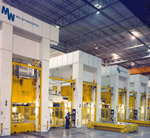An introduction to press safety standards and related guidance

Presses can be extremely hazardous, so it is important to know about the relevant standards and official guidance if safety is to be maintained. Kevin Ives, a consultant with Pilz Automation Technology, introduces the key documents.
Given the dangers inherent in power presses, it comes as no surprise that there are numerous standards and guidance documents devoted to the subject of press safety. Knowing your way around this literature is important if you are in any way responsible for press safety.
One of the main European standards is EN 693:2001 (and the British Standard equivalent BS EN 693:2001) 'Machine tools. Safety. Hydraulic presses.' While this standard contains a great deal of useful information, there is one aspect that is controversial - namely the option to use a 'two-hand control device' as the sole means of protection. In 2002 the HSE (Health and Safety Executive) lodged a formal complaint with the European Commission on the grounds that two-hand control devices protect the person operating the press but not others who can get access to the press tools. The HSE warned that it is prepared to take enforcement action against suppliers if hydraulic presses are not adequately safeguarded. Other UK bodies that supported the HSE's position included the Engineering Employers' Federation, the Safety Assessment Federation, the Machine Tool Technologies Association and the Confederation of British Industry.
Aside from the controversy surrounding two-hand controls, it should be remembered that alternative protective devices - light curtains, in particular - can provide safety for the operator and third parties, and also improve productivity. For example, if the safety-related control system is designed such that the press operates as soon as the operator's hands have cleared the light curtain, then there can be considerable savings in process cycle time compared with control systems relying on two-hand controls.
While it has taken many years to make progress over the question of two-hand control devices, by 2008 a compromise had been agreed, subject to a formal vote, so the standard may soon be revised.
EN 692:2005 (and BS EN 692:2005) 'Machine tools. Mechanical presses. Safety' is similar in many ways to EN 693 but, as the title suggests, it relates to mechanical presses. Note that in December 2007 EN 692 was amended by a corrigendum reference AMD 17169.
The third main standard for press safety is EN 12622:2001 (and BS EN 12622:2001) 'Safety of machine tools. Hydraulic press brakes.' Interestingly, unlike EN 693, EN 12622 does not permit the use of two-hand controls as a means of safeguarding the operating position during normal production work. Note also that a new draft of this standard was published for public comment in January 2004, though the 2001 version remains current for the time being.
Aside from the standards mentioned above, here in the UK the main advice relating to press safety is found in three HSE guidance documents.
HSG 236 'Power presses: maintenance and thorough examination' gives practical advice on how to maintain presses. There is also information on the selection of contractors and the records that should be kept. Some examples of maintenance records are provided as well as checklists and other information on what items need to be maintained and inspected, and when. The guidance refers to the safety-related aspects of the electrical control circuits including the need for up-to-date circuit diagrams. Particular checks must be performed at the 'initial' thorough examination of a press and additional testing may need to be performed at the 'periodic' examination and test.
Two other leaflets supplement HSG 236. 'Power presses: A summary of guidance on maintenance and thorough examination' (INDG 375) introduces HSG 236 and describes some additional items that are included within the scope of a statutory examination. 'Procedures for daily inspection and testing of mechanical power presses and press brakes' (INDG 316) gives detailed guidance to 'appointed persons' who carry out the daily checks on press guards and other safety devices.
As an official BSI Distributor, Pilz Automation Technology can supply copies of the press standards. HSG 236 can be purchased from HSE Books and both INDG 375 and INDG 316 are available to download as free PDF files from the HSE's website.
Pilz Automation Technology has undertaken numerous press-related projects in recent years. These have involved risk assessments, the development of safety concepts, the design of safety-related control systems, writing software for safety-related control systems, and CE marking imported presses (some of which have a CE mark attached but clearly fall short of the Essential Health and Safety Requirements of the Machinery Directive).
Furthermore, Pilz can also supply a range of products suitable for use in safety-related control systems for presses. These include the PSENvip vision-based press brake monitoring system, safety light curtains, safety relays, a version of the PNOZmulti modular safety controller specifically developed for press applications, and the PSS programmable safety and control system with approved software function blocks for the control of camshafts and press safety valves.
Similar articles
More from Pilz Automation Technology
- Safe automation: Learning how to do it 27th November 2018
- Safe sensor technology - automate with all your senses 2nd November 2018
- When were your light curtains last tested? 7th June 2017
- Decentralised Periphery PDP20 meets PLe for series connected switches 18th September 2012












Write a comment
No comments